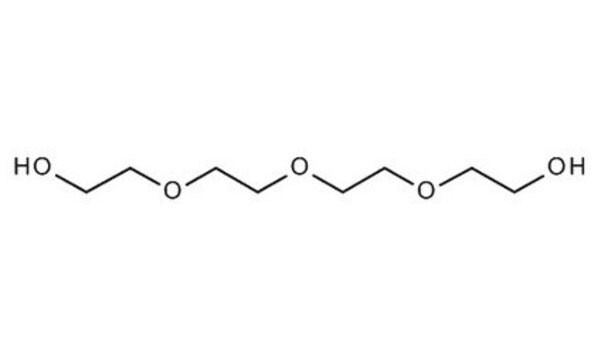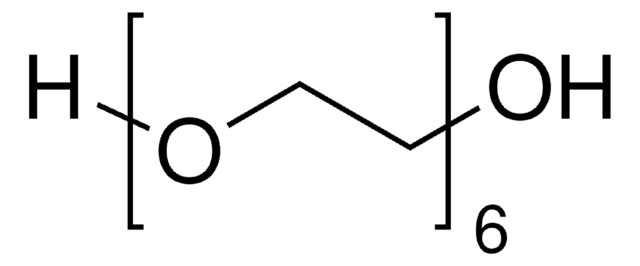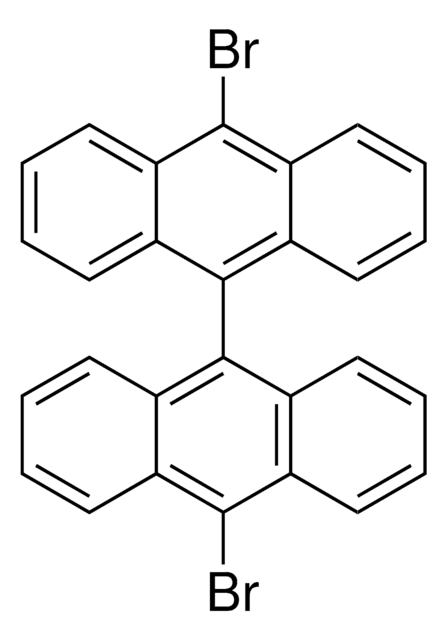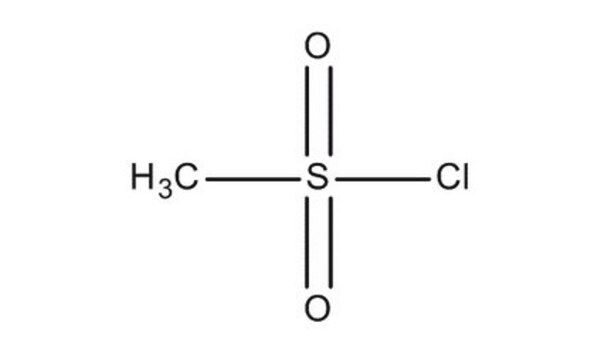8.08245
Triethylene glycol
for synthesis
Synonyme(s) :
Triethylene glycol, Triglycol
About This Item
Produits recommandés
Pression de vapeur
<0.01 hPa ( 20 °C)
Niveau de qualité
Pureté
≥99% (GC)
Forme
liquid
Température d'inflammation spontanée
370 °C
Puissance
17000 mg/kg LD50, oral (Rat)
>5000 mg/kg LD50, skin (Rat)
Limite d'explosivité
0.9-9.2 % (v/v)
pH
6.5-7.5 (20 °C, 100 g/L in H2O)
Point d'ébullition
285-295 °C/1013 hPa
Pf
-7 °C
Température de transition
flash point 165 °C
Densité
1.123 g/cm3 at 20 °C
Température de stockage
2-30°C
InChI
1S/C6H14O4/c7-1-3-9-5-6-10-4-2-8/h7-8H,1-6H2
Clé InChI
ZIBGPFATKBEMQZ-UHFFFAOYSA-N
Application
- Elucidating the Role of Reduction Kinetics in the Phase-Controlled Growth on Preformed Nanocrystal Seeds: A Case Study of Ru: This study explores the phase-controlled growth of ruthenium nanocrystals using triethylene glycol as a reducing agent, providing insights into the kinetics of nanomaterial synthesis for catalytic applications (Nguyen et al., 2024).
- Deep Eutectic Solvents as Agents for Improving the Solubility of Edaravone: Experimental and Theoretical Considerations: This research investigates the use of deep eutectic solvents, including those formulated with triethylene glycol, to enhance the solubility of edaravone. The findings demonstrate significant improvements in drug solubility and bioavailability (Jeliński et al., 2024).
- Probing the evaporation dynamics of semi-volatile organic compounds to reveal the thermodynamics of liquid-liquid phase separated aerosol: This study uses triethylene glycol in experiments to understand the evaporation dynamics and thermodynamics of semi-volatile organic compounds in liquid-liquid phase-separated aerosols. The research provides valuable data for atmospheric chemistry and environmental science (Choczynski et al., 2024).
Remarque sur l'analyse
Density (d 20 °C/ 4 °C): 1.123 - 1.124
Water (K. F.): ≤ 0.30 %
Identity (IR): passes test
Code de la classe de stockage
10 - Combustible liquids
Classe de danger pour l'eau (WGK)
WGK 1
Point d'éclair (°F)
330.8 °F - closed cup
Point d'éclair (°C)
166 °C - closed cup
Certificats d'analyse (COA)
Recherchez un Certificats d'analyse (COA) en saisissant le numéro de lot du produit. Les numéros de lot figurent sur l'étiquette du produit après les mots "Lot" ou "Batch".
Déjà en possession de ce produit ?
Retrouvez la documentation relative aux produits que vous avez récemment achetés dans la Bibliothèque de documents.
Les clients ont également consulté
Notre équipe de scientifiques dispose d'une expérience dans tous les secteurs de la recherche, notamment en sciences de la vie, science des matériaux, synthèse chimique, chromatographie, analyse et dans de nombreux autres domaines..
Contacter notre Service technique










![2-[2-(2-Aminoethoxy)ethoxy]ethanol ≥96.0% (GC)](/deepweb/assets/sigmaaldrich/product/structures/237/185/b94eadd2-5a2c-4a5b-a13d-3d3905df0dbc/640/b94eadd2-5a2c-4a5b-a13d-3d3905df0dbc.png)

